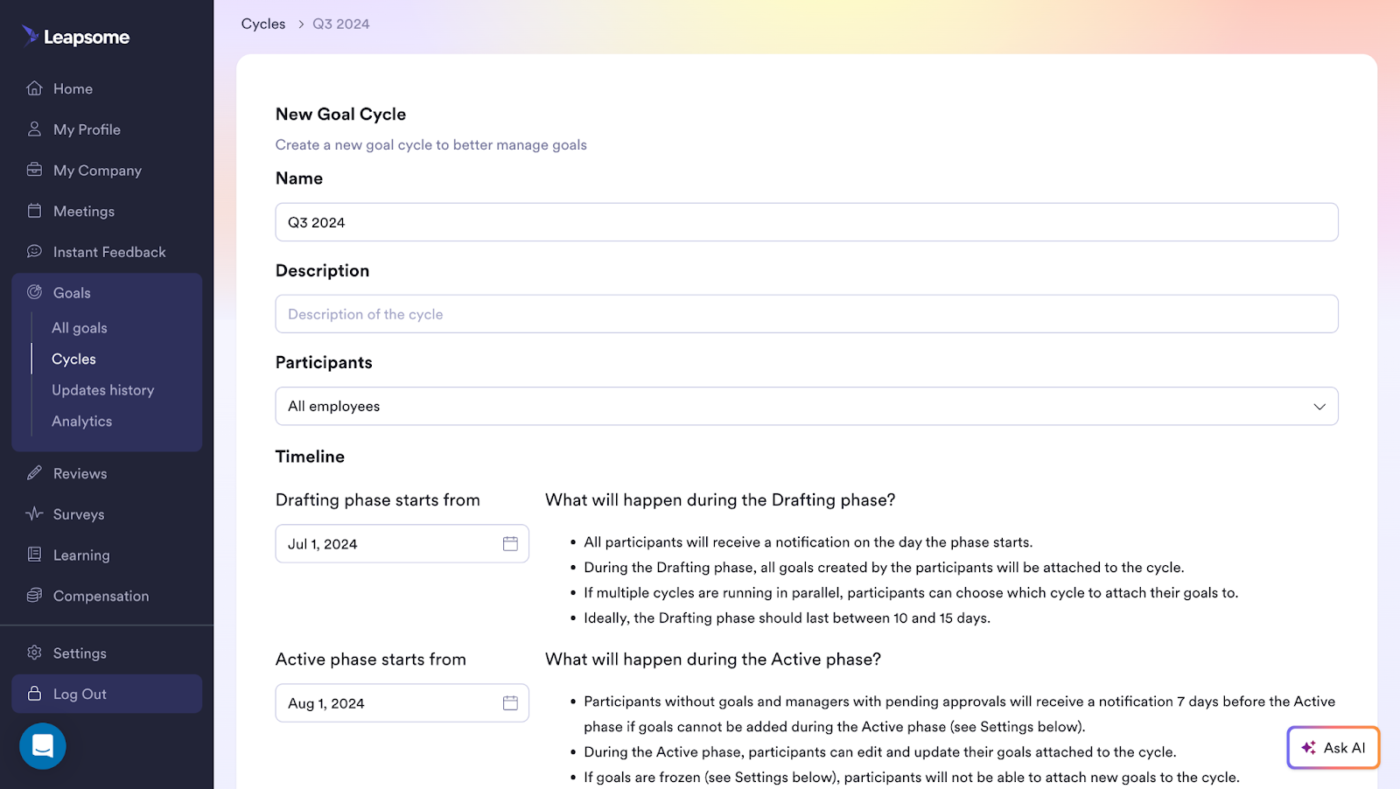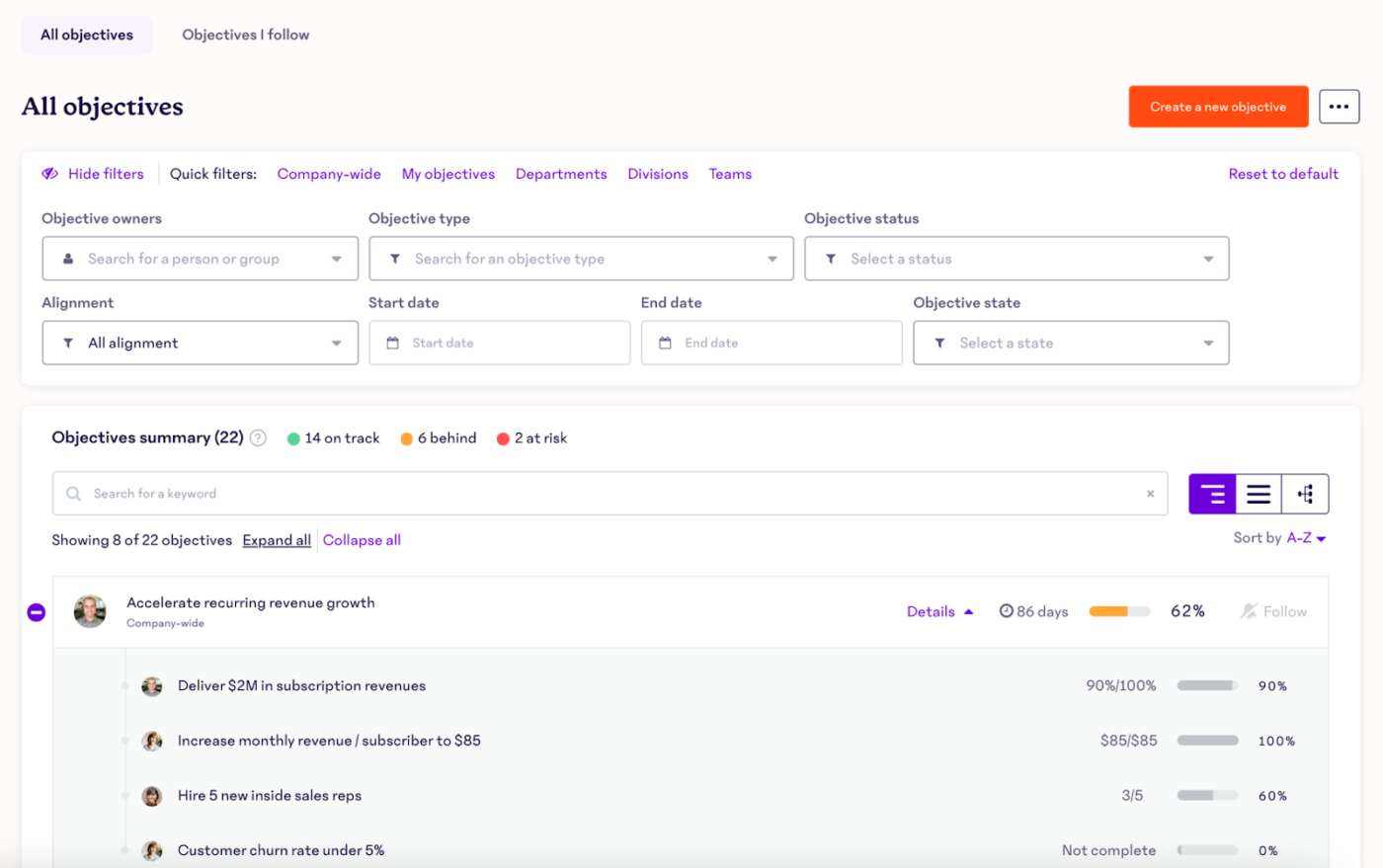Key takeaways
What is continuous performance management?
Continuous performance management is a style of performance management where team leads check in frequently with their direct reports. It’s a cycle made up of three steps: setting objectives, checking in with managers, and getting feedback.

In a continuous performance management cycle, the employee and manager work together to create goals and metrics to measure them. Then they have at least one check-in meeting where a manager can answer questions and address any issues that have arisen. Finally, they have a review meeting where a manager offers more formal feedback. This gives the two of them an opportunity to adjust or set new goals, and the cycle begins again.
Continuous performance management vs. standard review processes
What sets continuous performance management apart from the standard performance review is its frequency. Most traditional performance reviews are conducted annually, while continuous performance management includes opportunities for feedback every few weeks. Frequent feedback ensures clarity on expectations so employees feel more confident in their contributions, and it gives them an opportunity to improve by acting on that feedback.
“89% of HR managers think that continuous performance management is more useful than traditional performance management.” — BetterWorks
Continuous performance management is also different from putting an employee on a performance improvement plan (PIP), since the former is a cadence of feedback for all employees, while the latter is meant to help struggling employees meet their goals. However, the structure of a PIP and a continuous performance management strategy can be very similar, since both of them rely on consistent feedback and 1:1s between manager and direct report. In fact, continuous performance management can serve as a good alternative to using PIPs.
Benefits of continuous performance management
Continuous performance management offers a variety of benefits. It can improve employee performance and engagement, and it helps foster transparency in larger performance reviews.
Improves employee performance
It’s hard to know how to improve without consistent feedback from your manager. If you only get structured feedback once a year, you could have spent the last year learning bad habits and turning in work that didn’t meet expectations without knowing it. On top of that, there’s just not enough time in one meeting to discuss everything that needs to be done.
Continuous performance management gives more opportunities for that feedback. Not only does that direct an employee’s growth, it also provides role clarification. That, alongside consistent, guided goal-setting, ensures that employees are working on the right things that affect the company’s bottom line.
Increases employee engagement
Frequent, meaningful feedback makes you feel like what you do matters. If you’re just submitting work and moving on, it can feel like you’re not contributing to the broader organization. That has an impact, especially on the younger generation of workers; most of Gen Z want to do meaningful work that keeps them engaged.
“80% of employees who say they have received meaningful feedback in the past week are fully engaged.” — Gallup
In addition to constructive feedback, continuous performance management meetings are a great place to provide recognition for an employee’s good work. Recognition is another element that dramatically affects employee engagement; in a survey by Great Place to Work, 37% of respondents said they’d be motivated to do better work if they received personal recognition.
Fosters transparency
Continuous performance management provides a much more comprehensive record of employee growth and success than traditional performance reviews. Frequent goal-setting and reviewing means managers see the details of everything an employee has attempted and accomplished.
That’s incredibly important when it comes to those end-of-year overall reviews, which are often tied to promotion and compensation cycles. The more accurate record gives employees an opportunity to advocate for themselves and see that their hard work is rewarded with career growth. An employee using continuous performance management can go into an annual review confident that they are meeting the expectations set by their role and contributing to their company’s objectives.
Further reading: Why is Performance Management so Important?
How to implement the continuous performance management process
It’s one thing for a manager to set up a continuous performance management system with their direct reports. If you want to implement this system company-wide, though, HR needs to play a role.
Thankfully, the strategy for setting up continuous performance management isn’t too different from setting up any sort of performance management strategy, at least with regard to the decisions that need to be made.
You’ll need to decide on meeting cadences, create a universal goal-setting system, and make sure your managers are trained on how to provide effective feedback. Then, you’ll need to implement the change carefully, communicating openly, and giving people plenty of time to adjust.
1. Decide on meeting cadences
Meeting frequency is a difficult needle to thread. Too few check-in opportunities, and employees don’t get enough feedback. Too many, though, leaves people drowning in pointless meetings. There’s also the very real concern of Zoom fatigue.
There is plenty of research you can use as your baseline when it comes to determining meeting cadence. For example, according to research by TruQu, 76% of employees want feedback on their work at least once a month.
It might also be wise to allow for some wiggle room for individual managers; if they find that more or fewer meetings work for their team, they shouldn’t be punished for making that adjustment.
2. Create a goal-setting system
It’s important to make sure that your organization is aligned on how to create, set, and measure goals. Implementing a system like SMART goals, OKRs, or KPIs can help ensure consistency across the board.
It’s important to emphasize the scope of goals in a continuous performance management system. Whatever goals managers and direct reports are setting need to be reasonable within the timeframe of a review cycle. Using a goal-setting software like Leapsome or 15Five can be very helpful for keeping goals organized and measurable.
3. Train managers to provide effective feedback
Feedback is a learned skill. Anyone can offer their opinion, but it takes practice and training to give feedback that is effective and constructive. Unfortunately, it is a skill that many managers seem to be lacking. According to a report from Workleap, 64% of employees think the feedback they get from their managers could be improved.
Continuous performance management strategies rely heavily on the quality of a manager’s feedback for each employee’s success. As such, it’s important to make sure that those managers are well-trained before making the transition to any such system.
For tips on creating a training program that works, check out How to Create a Training Program for Effective Employees.
4. Communicate the process clearly
When making any major change to a company’s operational structure, it’s important to roll out the change slowly and with transparency. Simply dropping the plan on your managers’ laps and expecting them to implement it will only cause confusion. Communication and pacing are both key to rolling out continuous performance management.
When communicating this change, be clear about the steps and timeline of implementation. Explain the benefits of continuous performance management, and provide space to answer anyone’s questions or concerns.
Your communication strategy can’t end once the system is in place, either. Take time to gather feedback from managers and employees during the whole process, and make changes if necessary.
Further reading: Rethinking the Performance Appraisal: 4 Ideas for Improving Consistency Across Your Company
The role of continuous performance management software
The first and arguably most important use of performance management software is that it connects and organizes data. Software is a great resource to make sure employee goals are in line with organizational objectives and paint a fuller picture of an employee’s impact. Such systems of connecting data also help keep the consistency and alignment across the whole business.
Software also takes some of the administrative labor off of HR, giving them time to work on performance management strategy. Moreover, many apps can schedule review and 1:1 cadences, send reminders, and provide templates of review documents. These tools also keep track of employee compensation and job title changes over time.
Finally, many performance management apps have AI tools that assist in your strategy. Some AI tools provide insights and suggested action plans based on performance data. Others prevent bias by checking feedback language used by managers and monitoring equity and fairness in growth and compensation to meet DEI goals.
Every performance management software is different, and some might suit your needs better than others. Check out our handy Performance Management Software Guide to help determine which software is best for your business.







